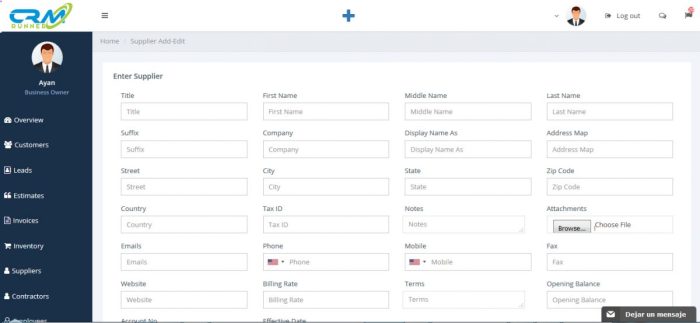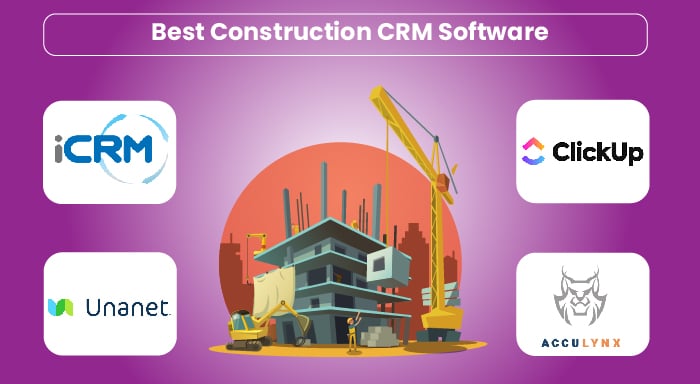Crm software for construction companies – The construction industry is known for its complexity, involving intricate projects, multiple stakeholders, and tight deadlines. Effective project management is paramount, and a robust Customer Relationship Management (CRM) system can be the key to unlocking efficiency and boosting profitability. This comprehensive guide explores the benefits of CRM software tailored for construction companies, outlining key features, selection criteria, and best practices for implementation.
Why Construction Companies Need CRM Software
Beyond simply managing contacts, a dedicated construction CRM offers a suite of features designed to address the unique challenges of the industry. These include:
- Improved Lead Management: Capture and nurture leads from various sources, track their progress through the sales pipeline, and automate follow-up communication.
- Enhanced Project Management: Centralize project information, track milestones, manage deadlines, and collaborate effectively with teams and subcontractors.
- Streamlined Communication: Facilitate seamless communication with clients, architects, engineers, and subcontractors through integrated messaging and document sharing.
- Better Client Relationship Management: Maintain detailed client profiles, track interactions, and personalize communication to foster stronger relationships and repeat business.
- Increased Efficiency and Productivity: Automate repetitive tasks, reduce paperwork, and improve overall team productivity.
- Improved Reporting and Analytics: Gain valuable insights into project performance, sales trends, and customer behavior to make data-driven decisions.
- Reduced Costs and Risks: Minimize errors, improve resource allocation, and enhance project control, ultimately leading to cost savings and risk mitigation.
Key Features of Construction CRM Software: Crm Software For Construction Companies
A successful construction CRM should incorporate several essential features:
Lead Management and Sales Pipeline
The system should effectively track leads from initial contact through to project completion. This includes features like lead scoring, automated email sequences, and sales pipeline visualization. Integration with other marketing tools is beneficial for a holistic approach.
Contact Management
Maintain detailed profiles of clients, subcontractors, architects, and other stakeholders. Store crucial information such as contact details, project history, communication logs, and payment information. This centralized database ensures everyone has access to the most up-to-date information.
Project Management Capabilities, Crm software for construction companies
The CRM should seamlessly integrate project management functionalities. This includes task assignment, deadline tracking, progress monitoring, document management, and resource allocation. Real-time dashboards provide a clear overview of project status.
Document Management
Centralize all project-related documents, including contracts, blueprints, permits, and invoices. Version control ensures everyone works with the latest versions, reducing confusion and errors. Secure storage and access control are critical.
Reporting and Analytics
Generate customizable reports to track key metrics such as sales performance, project profitability, and customer satisfaction. Analyze this data to identify areas for improvement and make data-driven decisions.

Source: psdcenter.com
Integration with Other Systems
Seamless integration with accounting software, project management tools, and other business applications is crucial for a streamlined workflow. This reduces data entry and eliminates the need for manual data transfer.
Mobile Accessibility
Access the CRM from anywhere, anytime, using mobile devices. This allows for real-time updates and communication, even when on-site.

Source: crmrunner.com
Customization and Scalability
Choose a CRM that can be customized to meet the specific needs of your construction business and can scale as your company grows.

Source: outrightcrm.com
Choosing the Right CRM for Your Construction Business
Selecting the right CRM involves careful consideration of several factors:
- Business Size and Needs: A small construction company may require a simpler, more affordable solution, while a larger enterprise may need a more comprehensive and scalable system.
- Budget: Consider the initial cost, ongoing maintenance fees, and potential return on investment.
- Integration Capabilities: Ensure the CRM integrates seamlessly with existing software and tools.
- User-Friendliness: The system should be intuitive and easy for your team to use.
- Customer Support: Reliable customer support is crucial for addressing any issues or questions.
- Security: Choose a CRM with robust security features to protect sensitive data.
Implementation and Best Practices
Successful CRM implementation requires careful planning and execution:
- Define Your Goals: Clearly Artikel your objectives for implementing a CRM system.
- Choose the Right Software: Carefully evaluate different CRM options based on your specific needs and budget.
- Data Migration: Plan for the efficient transfer of existing data into the new system.
- Training and Support: Provide adequate training to your team on how to use the CRM effectively.
- Ongoing Monitoring and Optimization: Regularly monitor the system’s performance and make adjustments as needed.
Frequently Asked Questions (FAQ)
- Q: What is the average cost of construction CRM software? A: The cost varies significantly depending on the features, scalability, and vendor. Expect to pay anywhere from a few hundred dollars per month to several thousand dollars per month for enterprise-level solutions.
- Q: How long does it take to implement a construction CRM? A: Implementation time depends on the size of your company and the complexity of the system. It can range from a few weeks to several months.
- Q: What are the key performance indicators (KPIs) to track with a construction CRM? A: Key KPIs include lead conversion rates, project completion rates, customer satisfaction scores, and revenue generated per project.
- Q: Can a construction CRM help with safety management? A: Some advanced CRM systems offer integration with safety management software, allowing for tracking of safety incidents, inspections, and training records.
- Q: How can I ensure data security with a construction CRM? A: Choose a vendor with robust security measures, including data encryption, access controls, and regular security audits. Follow best practices for password management and user access.
Resources
- HubSpot CRM (General CRM with potential construction integrations)
- Salesforce (Enterprise-level CRM with customization options)
- (Add other relevant links to CRM software providers or construction industry resources here)
Call to Action
Ready to transform your construction business with the power of a dedicated CRM? Contact us today for a free consultation and let us help you find the perfect solution to streamline your operations and boost your bottom line.
Clarifying Questions
What are the key features to look for in a construction CRM?
Key features include project management capabilities, contact management, lead tracking, document storage, reporting and analytics, and mobile accessibility.
How much does construction CRM software typically cost?
Pricing varies greatly depending on the features, number of users, and vendor. Expect a range from affordable monthly subscriptions to more substantial enterprise-level solutions.
Can a CRM integrate with existing software?
Many CRMs offer integration capabilities with accounting software, project management tools, and other business applications. This is a crucial factor to consider during selection.
How long does it take to implement a construction CRM?
Implementation time varies based on the complexity of the system and the size of the company. It can range from a few weeks to several months.
What kind of training is needed for employees to use a construction CRM?
Most vendors provide training resources, including online tutorials, documentation, and sometimes on-site training sessions. The level of training needed depends on the software’s complexity and user experience.
